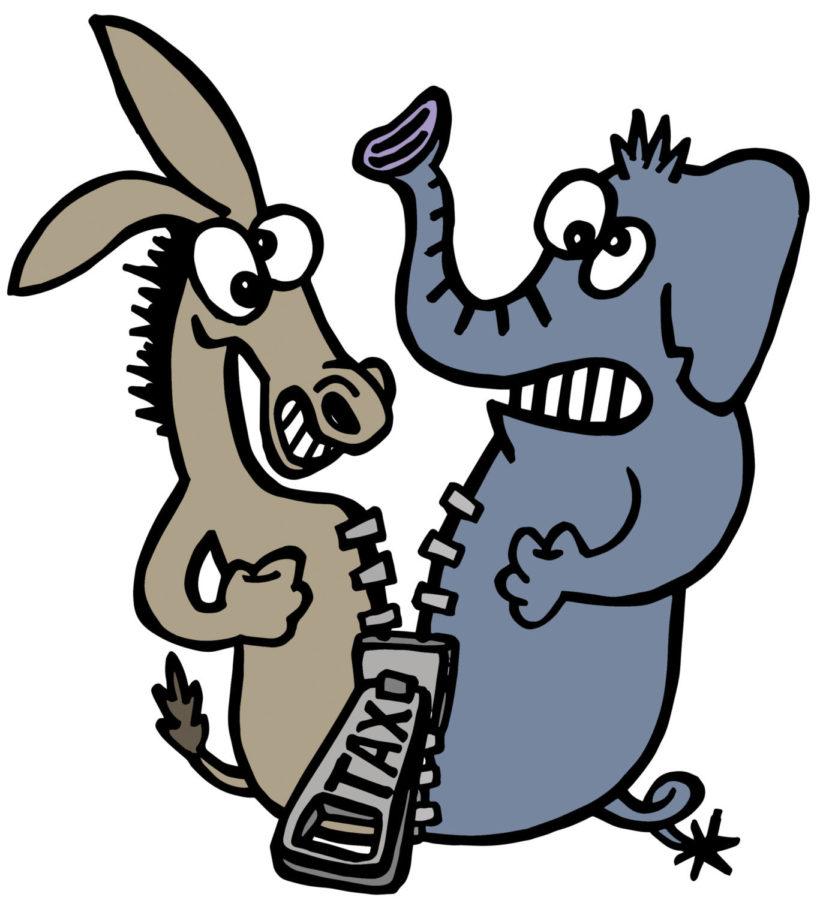Diwate: On tax cuts, political parties fundamentally diverge
Illustration: Ryan Francois/Iowa State Daily
Opinion: Diwate 1/15
January 15, 2013
The debate on the fiscal cliff mostly focused on cutting spending and raising revenue. One of the most contentious issues was taxes on the rich. Ultimately, both parties in the Senate agreed upon taxing the topmost layer of the income bracket. Democrats routinely call for higher taxes on the rich as part of their “fair share,” lowering taxes for the same economic group has been a hallmark policy of the Republican Party. Even after decades of experience with different policies, both the parties are still divided on the issue. So what beliefs make this issue a divisive one?
The approach to taxation has more to do with the way both the parties see the role of private businesses, government and campaign donors. For the Republican Party, private businesses create jobs at all levels and there should be incentive for them to grow. Low taxes can provide capital for expansion of the business. Lowering taxes was one of the fundamental principles of “Reaganomics “ or economic policies advocated by President Ronald Reagan. President George W. Bush also signed laws to this effect. (Reagan signed the Tax Reform Act of 1986, while Bush’s last bill for lowering taxes was the Job and Growth Tax Relief Reconciliation of 2003.)
Accordingly, a number of causes for tax-cuts are advocated by conservatives and related think-tanks. In a commentary piece, David Boaz of the Cato Institute argues that money should be kept by the people who earn it. Also, the rich are “job creators” and higher taxes can discourage job development. The tax cuts can put more disposable income in the people’s hands, thereby creating jobs: a working model of the “trickle down” economic theory. There are others who say if people keep more of their earnings per dollar, they’ll be encouraged to work harder in the future. Another contention point is that a higher tax rate will discourage investment and spending by the rich.
On the opposite side, the Democratic approach has been to emphasize the Keynesian idea to create jobs through government stimulus or spending. The belief lies in the economic principle that job-creation is not about more money in the hands of the rich, but overall demand in the economy which cannot be increased by tax cuts only. Where does the government look for revenue to be spent? So the Democrats push for higher taxes across the board, especially on the rich. I think this is where the sparks start to fly, as severe opposition from conservatives to raise taxes against the wealthy arise.
Apart from the federal income tax, there are other taxes subject to the debate. These taxes are the dividend tax and the capital gains tax: income from selling stocks. During the last presidential election, there was a lot of curiosity regarding presidential nominee Mitt Romney’s tax returns. As most of his income was from investment gains, he paid an effective tax rate of 14.1 percent. This is less than half in comparison with the maximum federal income tax rate of 35 percent. It can be considered a loophole as corporate CEOs are paid in stock to avoid the higher tax rate. It’s ironic that a person earning “idle” income on capital pays less tax than a person earning “working” income; i.e., someone who has invested a lot in stocks pays less tax on dividend and capital gains than someone who works a regular salary job, and pays a lot more in federal taxes.
Warren Buffett is among the few who has supported higher taxes for the rich and ultrarich. In an op-ed in The New York Times he writes, “So let’s forget about the rich and ultrarich going on strike and stuffing their ample funds under their mattresses. If — gasp — capital gains rates and ordinary income rates are increased, the ultrarich, including me, will forever pursue investment opportunities.”
An often overlooked aspect of this equation is the government revenue. Tax cuts naturally reduce government revenue and in turn affect long-term national investment in infrastructure, education and healthcare. So, the Republican idea to raise revenue is through closing loopholes. However, there is reason to believe that only closing loopholes won’t work to raise the needed revenue. Looking at the past, we see that top earners in the economy were taxed at least 70 percent and higher in the years 1940 to 1980. This period was also a “boom” period in U.S. history. Similarly, Clinton tax hikes in the ’90s were followed by steady economic growth. Definitely, there were a number of factors at play during the economic boom periods. But, looking at past experiences with tax, it is difficult to see how low taxes can foster growth or high taxes can kill the job market.
The questions and decisions regarding taxation become even more difficult due to political divisions. However, endless debates and inaction are not of any help either.
——————————————————————————————-
Varad Diwate is a freshman in journalism from Nashik, India.

















